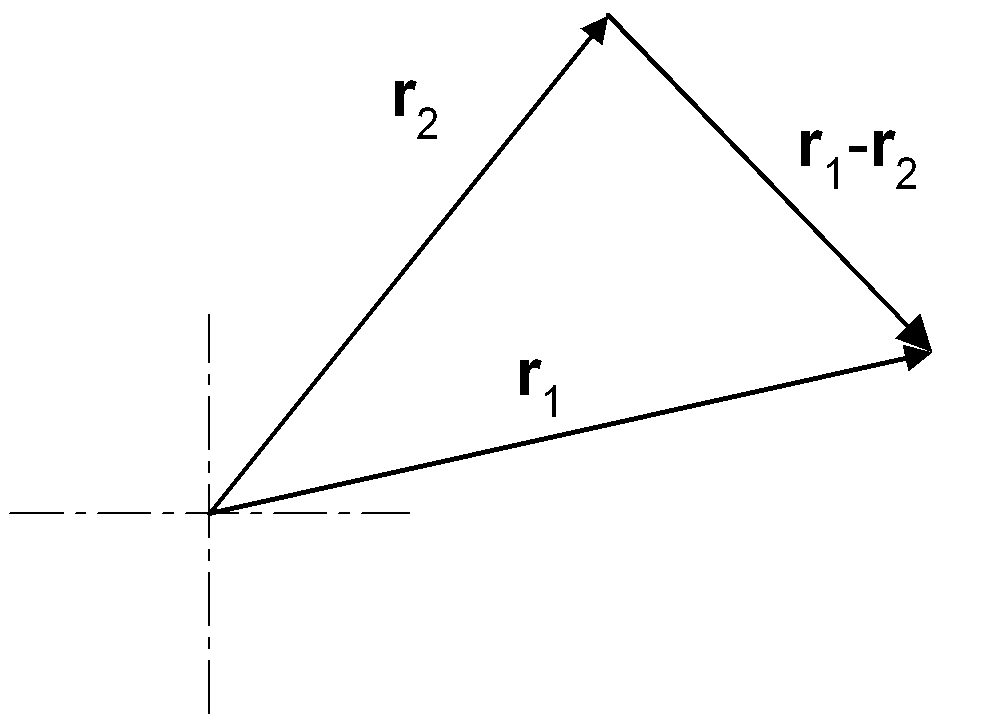rCM = (1/M)å i miri
Ftot = sum of external forces = dpCM/dt
For a single particle, angular momentum is defined as L = r ´ p. Angular momentum is a vector quantity, but has the odd property that it is perpendicular to the plane of motion -- the plane containing r and p. Perhaps you recall from introductory physics that the time rate of change of L is equal to the applied torque, N = r ´ F. We can derive this by evaluating the time derivative of L.
dL/dt = d/dt (r ´ p) = (dr/dt)´ p + r´ (dp/dt) = r´ (dp/dt) = r´ F = N
The first cross product is zero because the velocity is parallel to the momentum, v´ p = m(v´ v) = 0.
An angular momentum usually (but not always) means that we are dealing with some sort of rotation, like a spinning wheel, or planets orbiting a sun. A rotation has a center where it is natural to place the origin of coordinates, but up to now we haven't made use of this fact. We will now, in connection with the idea of central forces. A central force is one that points along the line connecting two interacting objects. The gravitational and electrostatic forces are central forces. Friction and the Lorentz magnetic force are not. If a situation involves a central force, and we measure position from the center of force, then r and F are parallel and the torque N is zero, and the angular momentum L is constant. This is the law of conservation of angular momentum: if the applied torque is zero then angular momentum is conserved.
We would like to derive a similar result for a system of particles. For a system of particles, we define the total angular momentum as the vector sum of the individual particle angular momenta, Ltot = å i Li = å i ri ´ pi . Let's look at the time derivative of this angular momentum.
dLtot/dt = åi [(dri/dt)´ pi] + åi [ri´ (dpi/dt)] = åi [ri´ (dpi/dt)]
As above, we'll use Newton's second law to substitute the force on particle i for the momentum derivative term. When considering a single particle, all forces are external. This time though, we have internal and external forces. From the previous lecture we have:
dpi/dt = Ftoti = Fi + åj Fji
Inserting this expression in the one above gives:
dLtot/dt = åi ri´Fi + å iå j ri´Fji = åi ri´Fi = Ntot

the result we wanted. The double sum of the internal forces is zero assuming that the forces between particles are central. Here's the explanation. Due to Newton's third law, for every force Fji ¹ 0 its pair Fij ¹ 0. Combining these two terms yields
ri´ Fji + rj´ Fij = ri´ Fji - rj´ Fji = (ri - rj)´ Fji = 0
The quantity ri - rj is a vector pointing from particle i to particle j. If Fji is a central force, then it also points along the line from particle i to particle j, and therefore the vectors in the cross product are parallel, so the cross product is zero.
Since we will often deal with the CM, it is useful to express the angular momentum in terms of the CM of the system. Recall how we used CM coordinates in the example from last lecture. Let's do that again here, r'i = ri - rCM , and likewise we can express the velocity in terms of the CM velocity and the part relative to the CM.
Ltot = å
i (rCM + r'i)´
mi(vCM + v'i) = rCM ´
pCM + rCM ´
å
i miv'i + å
i mir'i ´
vCM + å
i mir'i ´
v'i =
rCM ´
pCM + å
i r'i ´
p'i
To reach this solution I've used å i miv'i = 0 and å i mir'i = 0. Can you see why these are true? Hint, try calculating rCM by expressing the coordinates in terms of the CM coordinates and the coordinate of the CM.
The above result says that the total angular momentum of a system of particles is composed of two parts: the angular momentum of the CM and the angular momentum about the CM. The second part is what we normally think of as the rotation or spinning of something. The first part we might consider as the angular momentum due to the orbit, or path of our system. This is quite a convenient occurance; the center of mass is a special point indeed.
Let's summarize. The motion of the center of mass is governed by the external forces acting on the system. Internal forces contribute to internal motion, but don't affect the motion of the CM. The time rate of change of the total angular momentum of a system equals the net external torque. The total angular momentum is composed of two components, the angular momentum due to rotations about the center of mass, and the angular momentum of the orbit of the center of mass.
![]()
Ó
20 February, 1999 R. Harr